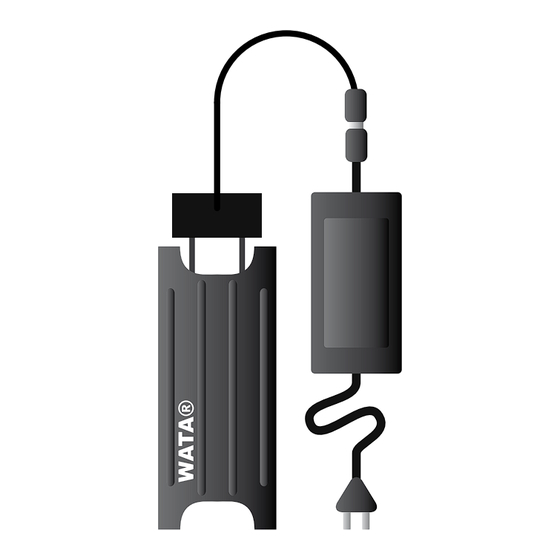
Table of Contents
Advertisement
Advertisement
Table of Contents

Summary of Contents for WATA Standard
- Page 1 WATA-Standard OPERATING INSTRUCTIONS...
-
Page 2: Table Of Contents
INDEX 1. Presentation ....................... 3 2. Necessary materials ..................4 3. Recommendations for the production of sodium hypochlorite ......4 4. Water quality ....................... 6 5. Sources of electricity/energy ................8 6. Procedure for producing sodium hypochlorite solution ......... 10 7. -
Page 3: Presentation
The WATA-Standard produces a sodium hypochlorite solution by electrolyzing salt water. All that is needed are clear water, salt and electricity to use the WATA-Standard. Water is chlorinated by adding a dose of sodium hypochlorite to potentially contaminated water, thereby destroying at least 99% of pathogenic microorganisms in approximately 30 minutes. -
Page 4: Necessary Materials
If this is the case, use a voltage regulator. Use with a generator The generator should not run out of fuel while the WATA-Standard is in use. Wait until the generator is stable before plugging in the WATA-Standard. - Page 5 To facilitate the monitoring of chlorine production and to trace the origin of problems that might arise, use a log book to record, each time the WATA-Standard is used, the name of the person responsible for production, the starting and finishing times of production and a short description of the procedure.
-
Page 6: Water Quality
Always clean the WATA-Standard after use After each use, rinse the WATA-Standard with clean water. If after several uses you notice white marks on the WATA-Standard, prepare a solution of 50% vinegar (or lemon juice) and 50% clean water. Leave the device to soak for several hours and then rinse it with clear water. - Page 7 Then place the bottle over the WATA logo and look at it from above through the bottle.
-
Page 8: Sources Of Electricity/Energy
USING DIRECT SOLAR POWER For use with direct solar power, plug the WATA-Standard device directly to a solar electric panel using the crocodile clips provided. The solar panel should deliver 12 V DC, its size depending on the amount of solar radiation at the point of use. - Page 9 The battery should deliver 12 V DC. A 2 L production with the WATA-Standard consumes 8 Ah of the battery’s capacity. For an idea of the capacity possible when using a battery with the WATA-Standard,...
-
Page 10: Procedure For Producing Sodium Hypochlorite Solution
6. PROCEDURE FOR PRODUCING SODIUM HYPOCHLORITE SOLUTION 6.1 PREPARING THE SATURATED BRINE Take a container of any size (but it must not be of metal) and fill it with water. Add large quantities of salt (approximately 400 g of salt per litre of water). Preferably use refined salt. -
Page 11: Storage
Once the brine solution is ready, totally immerse the WATA-Standard device in the solution. Connect the WATA-Standard device to the electrical mains (110 or 220 V). When using solar energy, connect the WATA-Standard device’s connector clips to the rechargeable battery or the solar panel taking care to connect them to the right terminals. -
Page 12: Measuring Active Chlorine Concentration (Watatest)
WataTest QUALITY CONTROL CHECK FOR CONCENTRATED CHLORINE SOLUTION PRODUCED BY WATA Contrôle de qualité d'une solution concentrée de Materials: WataTest reagent, 1 mL syringe (supplied), graduated chlore produite par le WATA pipette (supplied), small container with a white base. -
Page 13: Using Sodium Hypochlorite Solution To Chlorinate Drinking Water
At this dose, 1 litre of sodium hypochlorite at a 6 g/L concentration produced by the WATA device can be used to treat approximately 4,000 litres of water, if the initial water quality is compliant with the above-mentioned turbidity and pH criteria. - Page 14 INDICATIVE DOSAGES FOR CHLORINATING DRINKING WATER DEPENDING ON THE CONCENTRATION PRODUCED BY WATA: Volume of water to be disinfected 10 L 20 L 100 L 3 g/L 5.0 mL 10.0 mL 50.0 mL 4 g/L 3.8 mL 7.5 mL 37.5 mL...
-
Page 15: Testing Drinking Water With Watablue (Determination Of Residual Chlorine)
10. TESTING DRINKING WATER WITH WATABLUE (DETERMINATION OF RESIDUAL CHLORINE) The WataBlue reagent test determines the concentration of residual chlorine in the treated water. Materials : WataBlue reagent, graduated pipette, test tube (all supplied). Always carefully rinse the test tube between tests. WataBlue RESIDUAL CHLORINE MEASUREMENT CHECK... -
Page 16: Using The Sodium Hypochlorite Solution For Disinfection/Cleaning
If you needed to add 4 times the initial amount of chlorine, i.e. 20 mL (as opposed to 5 mL) for 20 litres, that means that the water is too cloudy for the sodium hypochlorite to act and your water must be filtered once again (see section 4) and the chlorination process must be repeated. - Page 17 Vol. of sodium Advised hypochlorite concentration Vol. of equivalent to a Procedure water of chlorinated concentration solution of 6 g/L Soak garments in the chlorinated solution for 5 min, then rinse Clothing / laundry 0.2 g/L carefully. Do not use chlorine to disinfect wool, silk or nylon.
-
Page 18: Stabilising The Chlorine Solution
12. STABILISING THE CHLORINE SOLUTION To use a sodium hypochlorite solution produced by the Midi-WATA electrical chlorinator device after more than 24 hours, we propose a stabilisation method using caustic soda (NaOH). This new process requires the use of a pH meter or pH testing strips. Laboratory skills and equipment are also required, but the process ensures a six-month minimum storage life. - Page 20 FONDATION ANTENNA TECHNOLOGIES Av. de la Grenade 24 1207 Genève Suisse T : 0041 22 737 12 40 Email : wata@antenna.ch WWW.ANTENNA.CH...
Need help?
Do you have a question about the Standard and is the answer not in the manual?
Questions and answers